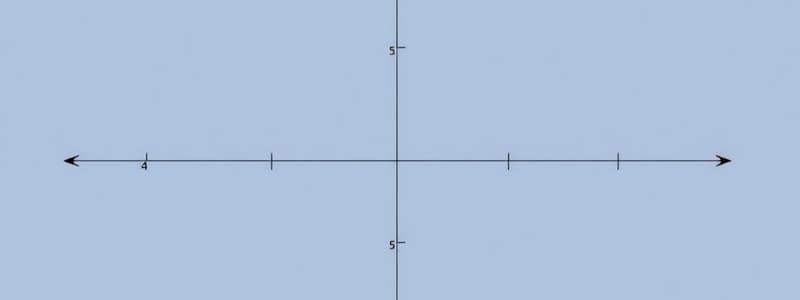Podcast
Questions and Answers
Which of the following statements is true regarding vector quantities?
Which of the following statements is true regarding vector quantities?
- Vector quantities cannot be added.
- Vector quantities have only magnitude.
- Vector quantities have both magnitude and direction. (correct)
- Vector quantities are always positive.
A scalar quantity does not possess a direction.
A scalar quantity does not possess a direction.
True (A)
What are the coordinates used in a Cartesian coordinate system?
What are the coordinates used in a Cartesian coordinate system?
(x, y)
A vector's __________ is the shortest distance between its end points regardless of the trajectory.
A vector's __________ is the shortest distance between its end points regardless of the trajectory.
Match the following terms with their correct descriptions:
Match the following terms with their correct descriptions:
In which quadrant would the Cartesian coordinates (-3.50, -2.50) be located?
In which quadrant would the Cartesian coordinates (-3.50, -2.50) be located?
The magnitude of a vector is always zero if the vector points in the opposite direction.
The magnitude of a vector is always zero if the vector points in the opposite direction.
Give an example of a scalar quantity.
Give an example of a scalar quantity.
Which of the following is true about displacement and distance?
Which of the following is true about displacement and distance?
Vectors can only be added using graphical methods like the parallelogram method.
Vectors can only be added using graphical methods like the parallelogram method.
What is the significance of unit vectors in vector representation?
What is the significance of unit vectors in vector representation?
The resultant vector of two vectors can be calculated using the _____ method.
The resultant vector of two vectors can be calculated using the _____ method.
Match the following properties of vectors with their definitions:
Match the following properties of vectors with their definitions:
When a vector is multiplied by a scalar, what is the result?
When a vector is multiplied by a scalar, what is the result?
Two vectors are equal if they have the same magnitude and direction.
Two vectors are equal if they have the same magnitude and direction.
What defines a scalar quantity?
What defines a scalar quantity?
Flashcards
Vector quantity
Vector quantity
A quantity with both magnitude and direction.
Scalar quantity
Scalar quantity
A quantity with only magnitude, no direction.
Cartesian coordinates
Cartesian coordinates
A coordinate system using perpendicular axes (x, y).
Polar coordinates
Polar coordinates
Signup and view all the flashcards
Displacement vector
Displacement vector
Signup and view all the flashcards
Vector addition
Vector addition
Signup and view all the flashcards
Vector components
Vector components
Signup and view all the flashcards
Vector equality
Vector equality
Signup and view all the flashcards
Vector equality
Vector equality
Signup and view all the flashcards
Vector addition (parallelogram)
Vector addition (parallelogram)
Signup and view all the flashcards
Vector addition (triangle)
Vector addition (triangle)
Signup and view all the flashcards
Vector components
Vector components
Signup and view all the flashcards
Unit vectors
Unit vectors
Signup and view all the flashcards
Resultant Displacement
Resultant Displacement
Signup and view all the flashcards
Vector Subtraction
Vector Subtraction
Signup and view all the flashcards
Vector multiplication by a scalar
Vector multiplication by a scalar
Signup and view all the flashcards
Study Notes
Course Content
- Course covers Physics, with chapters including Physical Quantity, Units, and Dimensions (1 week); Motion in One Dimension (2 weeks); Vector Analysis (2 weeks); Waves, Oscillations, and Sound (2 weeks); Light, Lenses, and Mirrors (2 weeks); Heat and Thermodynamics (2 weeks); and Electricity & Magnetism (2 weeks).
Chapter 3: Vector Analysis
- Vectors & Physics: Vectors have magnitude and direction. A vector is represented as F = 7i − 5j + 3k. Components of a vector are calculated using trigonometry (Fx = F cos θ; Fy = F sin θ). Vectors are used to find the resultant vectors.
- Coordinate Systems:
- Cartesian (rectangular): Points are labeled (x, y).
- Plane polar: Points are labeled (r, θ).
- Relations Between Systems: Conversions between Cartesian and polar coordinates:
- x = r cos θ
- y = r sin θ
- r = √(x² + y²)
- θ = tan⁻¹(y/x)
- Vector and Scalar Quantities:
- Scalar: Only magnitude (e.g., temperature).
- Vector: Magnitude and direction (e.g., velocity).
- Vectors' Notations: Text-book notations (bold) and other notations (with arrows).
- Displacement Vector: The magnitude of the displacement vector is the shortest distance between the end points (A and B), regardless of the trajectory.
- Vector Properties:
- Equality: Two vectors are equal if their magnitudes are equal and they point in the same direction.
- Addition (Triangle Method, Parallelogram Method): methods for adding vectors.
- Addition: (More than two vectors) Polygon Method.
- Commutative Law: A + B = B + A
- Associative Law: (A + B) + C = A + (B + C)
- Negative of a vector: The negative of a vector has the same magnitude but points in the opposite direction.
- Subtraction: A - B = A + (-B)
- Multiplication: The scalar multiple of a vector (m * A) is parallel or antiparallel to A with magnitude |m| * |A|.
- Components of Vectors and Unit Vectors:
- A vector's components are its projections along coordinate axes (e.g., ax, ay).
- Unit vector notations are for directions (î, ĵ, k).
- Vector components are Ax=A cos θ; Ay = A sin θ; Direction of A = tan⁻¹ (Ay/Ax)
- Sum of Vectors Using Components: Vectors are added by adding their corresponding components. R = Ax + Bx, Ry = Ay + By.
- Vectors in Three Dimensions: Vectors are expressed as A = Ax î + Ay ĵ + Az k. Vectors are added component-wise.
Additional Topics
- Application Examples: Work problems involving displacement vector calculations (e.g., car travel). Given Cartesian coordinates to find magnitude and direction. Problem examples from the homework exercises.
- Quick Quizzes: Identify scalar vs. vector quantities, possible magnitudes of sums, and conditions for resultant vector magnitude.
- Homework Problems: Specific problems to solve (e.g., HW-3 Serway Version 8 Problems 5, 15, 31, 37 and 43).
Studying That Suits You
Use AI to generate personalized quizzes and flashcards to suit your learning preferences.




